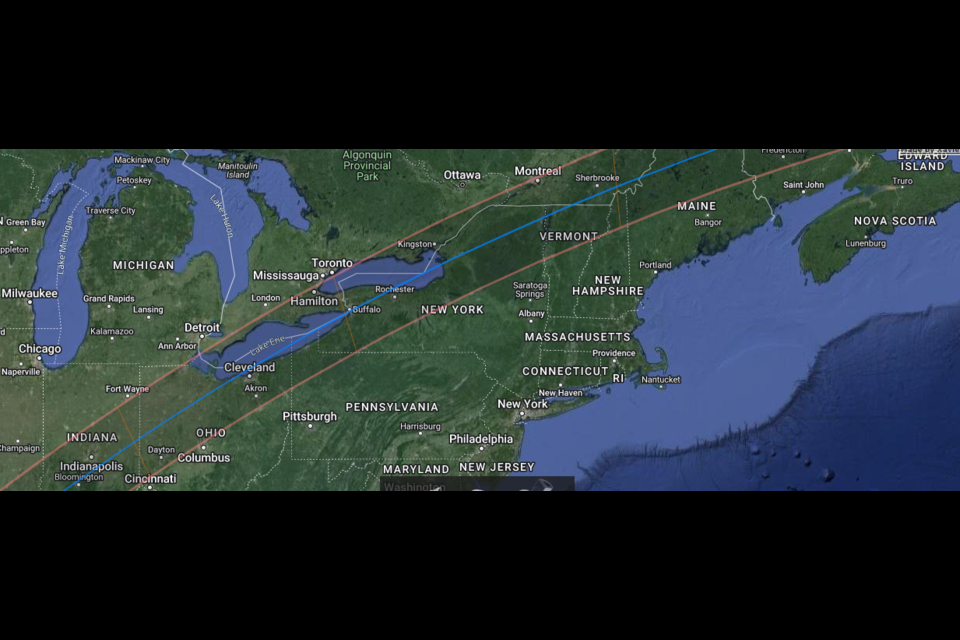If there’s still any need for you to be convinced that the upcoming total solar eclipse to be visible across Niagara on April 8 is a big deal, consider the fact that the Ontario Eclipse Task Force has been discussing the event for several years.
Astrophysicist Dr. Ilana MacDonald of the University of Toronto’s Dunlap Institute for Astronomy and Astrophysics is the chair of the group which has brought together representatives from different institutions across the province to plan for the celestial phenomenon.
Representing Niagara, assistant physics professor Barak Shoshany is Brock University’s representative on the task force.
“We wanted to make sure that the events were coordinated across the different universities, parks, organizations such as the Royal Astronomical Society of Canada (RASC) and science centres,” MacDonald said during an interview on YourTV’s The Source.
MacDonald explained that the timing and the location of the path of totality for the 2024 solar eclipse is something that was predicted many years ago.
“We know when the next few eclipses are going to happen over the next few hundred years,” she said. “We’ve known that this one would be on this date for the last couple of hundred years, certainly. The sun and the moon and the earth’s movements are pretty easy to predict.”
She added, “It all goes back to the time of Isaac Newton. Eclipses have been easy to predict since then”
When the task force comes together, each member shares their plans for the eclipse. In addition, sub-committees were formed to prepare and share educational materials and to reach out to municipalities to help them prepare.
“A lot of the worries are about traffic congestion,” MacDonald explained when asked about Niagara being in the path of totality, “and all the hotels being booked up in the area. When people know an eclipse is happening in a certain area, they will go to that region because it is such a spectacular event.”
In 2017, she recalled, in some areas of the United States that were in the path of totality, a one-hour drive to an ideal spot to see the eclipse became as much as a 12-hour drive to get back to their origin. Members of the task force, especially those from the RASC, work with Ontario’s municipalities to help them put precautions into place to avoid any disasters and to ensure emergency services can still respond promptly.
This reporter was in Banff, Alberta with his family in August 2017 when that area experienced a partial eclipse of the sun. The afternoon daylight dissolved into temporary darkness and the hot summer temperature dropped drastically to the point where a heavy sweater or jacket would have been preferable. It was a memorable experience.
“In the path of totality you will see the moon completely block the sun’s surface with its shadow,” MacDonald explained. “Since all of the light is blocked out by the sun, the entire sky will get to the darkness of about twilight. And you’ll notice a dramatic temperature change.”
Those conditions, she continued, will fool Mother Nature. Birds will fall asleep, flowers will close and other animals will think it is nighttime.
Visually, it will be an incredible sight, as long as you are wearing the proper eyewear to watch it. The black circle of the moon’s shadow will gradually move across the sun’s circle until it is completely blocked. A halo of light called the corona, will surround the moon’s shadow.
Totality will last for a couple of minutes, MacDonald adds.
For many, this will be a once-in-a-lifetime experience. Another total eclipse of the sun will not be visible in Canada until 2044, but you’ll have to be in the Northwest Territories or Nunavut to experience it. Atlantic Canada will be the best place to see the one after that in 2079.
So watching this one happen right here at home in less than a month will be quite the experience. But MacDonald warns it has to be watched the right way.
“It’s dangerous to look at the sun any day,” she said. “The sun is the brightest possible thing you could look at in the sky. As long as you use proper eclipse glasses, ones that are approved by the International Society of Optometrists, it’s perfectly safe to look at it.”
MacDonald herself has never actually experienced a total eclipse.
“From what I’ve heard from my colleagues who have experienced one,” she enthused, “it seems like an amazing life-changing event. I am definitely geeking out about it.”
She hasn’t decided yet where she will be for that experience. As the path of totality includes the Hamilton-Burlington area, as well as Prince Edward County through to Kingston and into Quebec, she is keeping her options open.
She’s even floated the idea of renting a boat to sail south from Toronto for a perfect vantage point.
Finally, she and other task force members remind to plan ahead for April 8, and to be sure that those plans include extra time for travel.
In addition to being a reporter for The Local, Mike Balsom is also the host of The Source on YourTV Niagara. On April 8 he will be hosting YourTV’s live coverage of the total eclipse beginning at 2:00 p.m. from Niagara Falls.
Other ECLIPSE 2024 articles in the NOTL Local:
St. Davids students take a trip to the moon
Niagara police and emergency services ready for the biggest crowds ever
Whether through special glasses or a colander, watch it safely
